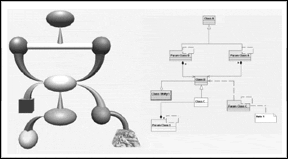Extruded
Graphs ... cont |
|
It is interesting to note that these charts borrow two-dimensional
conventions of connecting the zero points of the data in the far
corner. The rotation of the data, it's pivot point is in the center
of the model. When rotated the data follows paths dictated by the
center point and not the zeroed corner Unlinked, the ability to
use the rotation of the model for data visualization fails. |
Process |
|
Spatial Narrative Given the comparative nature of data in charts and graphs, It is
unclear if this is possible, clearly a breakthrough would be needed.
To be honest, these are just musings and my efforts so far scattered
and ungrounded in user research. For the above issue, I can only
offer the Dali menu which touches on the occlusion of data (it disappears
behind the viewer) By default, this allows more focus on the data
in front of the user.
|
[ next page ] |